AMD Launches Mobile Kaveri APUs
by Jarred Walton on June 4, 2014 12:01 AM ESTAMD Kaveri FX-7600P GPU Performance Preview
Given the 3DMark results we just showed as well as the increase in CPU performance, I was very interested to see what Kaveri could do in terms of gaming performance. Here I have to temper my comments somewhat by simply noting that the graphics drivers on the prototype laptops did not appear to be fully optimized. One game in particular that I tested (Batman: Arkham Origins) seemed to struggle more than I expected, and there are other games (Metro: Last Light and Company of Heroes 2) that will bring anything short of a mainstream dGPU to its knees. I've posted the Kaveri Mainstream and Enthusiast scores in Mobile Bench, but they're not particularly useful as most of the scores are below 30 FPS. Here, I'll focus on our "Value" settings, which are actually still quite nice looking (Medium detail in most games).
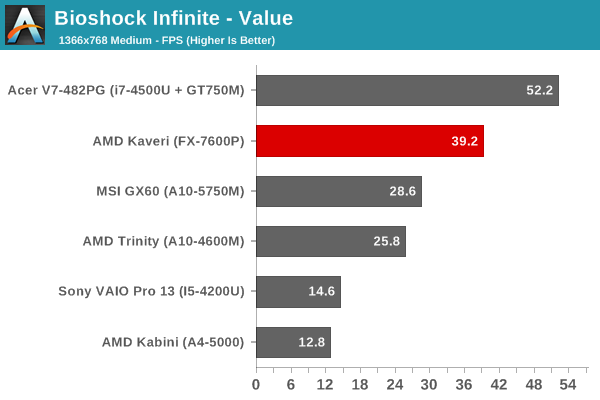
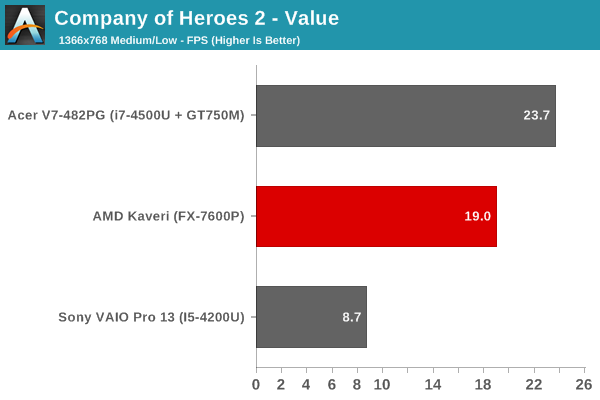
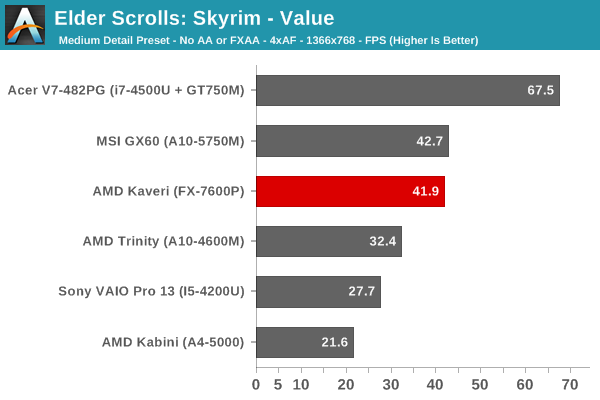
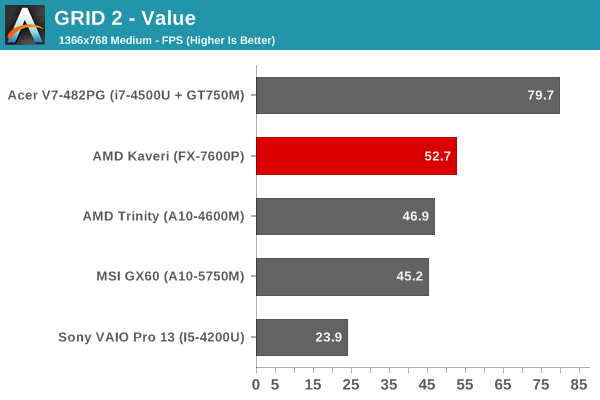

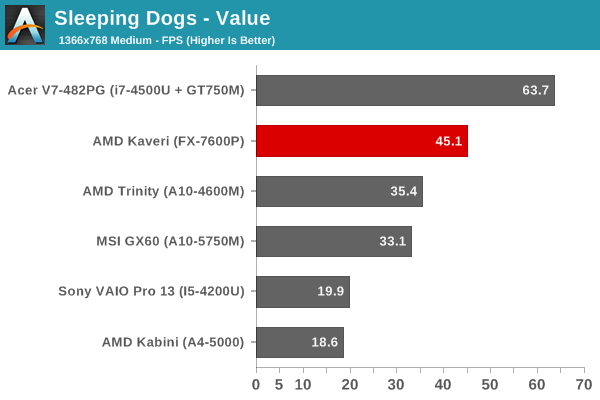
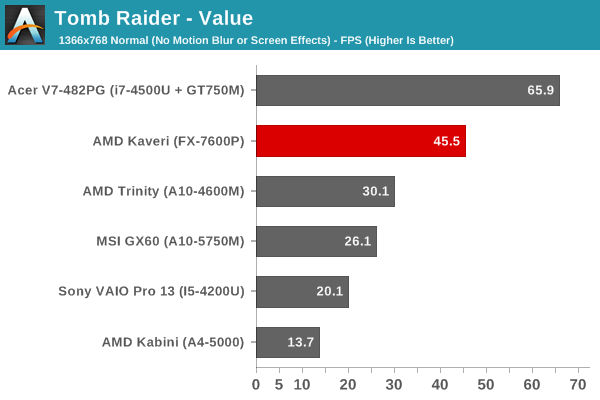
As expected, in most of the tests the Kaveri APU is able to surpass the gaming performance of every other iGPU, and in some cases it even comes moderately close to a discrete mainstream dGPU. There's a sizeable gap between the Trinity/Richland APUs and Kaveri in most of the games I tested, which is great news for those looking for a laptop that won't break the bank but can still run most modern games.
Getting into the particulars, Skyrim seems to be hitting some bottleneck (possibly CPU, though even then I'd expect Kaveri to be faster than Richland), but the vast majority of games should run at more than 30 FPS. There was one system with a pre-release Mantle driver installed that was running Battlefield 4 reasonably well at low/medium details, and with shipping laptops and drivers (and perhaps DDR3-2133 RAM) I suspect even Metro might get close to 30 FPS. Of course, we're only looking at the top performance FX-7600P here, so we'll have to see what the various 19W APUs are able to manage in similar tests.










125 Comments
View All Comments
CoronaL - Wednesday, June 4, 2014 - link
lol me toomax1001 - Wednesday, June 4, 2014 - link
I would love to see a nicely spec ultrabook with this APU and $800-$1k price point that can do decent gaming.AnnonymousCoward - Wednesday, June 4, 2014 - link
It'd be fun to throw a GTX 760 in the mix, just to see where we're at.CoronaL - Wednesday, June 4, 2014 - link
Wonder if they will pair that up with a cheap 250x mobile version for some X-fire gaming on laptop. I bet that would beef up the graphics a fair bit. IMO the cpu part is pretty respectable trading blows with the i7 and i5 for the most part, which AMD usually gets trounced in.azazel1024 - Wednesday, June 4, 2014 - link
Well it does look a lot better than Richland and price might be a big driver in making these interesting (I see no prices?), but 19w Kaveri versus 15w Haswell ULT...the 15w Haswell ULT, depending on the turbo performance of the 19w Kaveri part looks to run roughly as fast to a very sizeable 20-30% lead in CPU performance and with the GPU cut down to roughly half performance between core and clock reduction...the Haswell ULT is likely to be on par graphically +/-10%. In a lower power consumption package...and if the Kaveri has turboing issues or the GPU is thermally constrained in this package it could be a much more significant lead.The 15w Kaveri doesn't look like it would be on the performance map at all (<<<50% of the performance of Haswell ULT). The standard voltage parts actually look the most interesting, especially if the price is moderate. That would probably allow you to make a decent performing machine (70-90% of an Intel's CPU performance) with a very nice iGPU for a rather low price point (assuming the FX-7600p is very price competitive to the Intel Haswell SV dual core parts).
azazel1024 - Wednesday, June 4, 2014 - link
I guess I missed something with the Intel chips in regard to the TDP. My experience is vastly different. Most Intel chips, both desktop and mobile, don't seem to come close to hitting max TDP under full CPU load. Especially in the desktop space I see something like my i5-3570 with a TDP of 77w is hitting around a 35w delta between idle and full load based on wall plug data, considering losses from the power supply and assuming a fairly low (CPU) idle number, thats only in the area of 30-40w total power consumption. That isn't simply under load, the processor is clocked up to 4.2GHz single core and 4GHz all 4 cores turbo. That isn't a max burn situation where every single itty bitty capacitor and transistor is loaded like Intel does in their TDP tests, but that is under 100% sustained CPU load across all 4 cores.From what I have seen with Ivy Bridge testing (which ain't Haswell I'll admit) a fully loaded i5-3317u seems to only use in the area of 8-10w with both cores fully loaded max turbos 100% CPU load. Its the GPU that uses a huge whack of power, >12w under max load and turbos.
I'd assume Haswell is pretty close there, at least with the CPU, since the turbo core speed is the same, same lithography, very similar architecture. So I doubt a ULT Haswell is using more than 10w under max CPU load and turbos. Its the GPU that is going to be the power hog.
No idea what AMD is capable of on these, but we know they are using a less energy efficient process, so I'd assume/guess that their CPU is probably below the cap under max CPU load, but it might be much closer, maybe in the 12-15w range under max turbo, meaning GPU load is going to cause the CPU to scale pretty far back, even on the 19w chips.
worm - Wednesday, June 4, 2014 - link
It seems like any benchmarks of the Ax-7xxxP should be against an ix-4xxxM, not MQ, like over at Tom's, and the 7xxx, should be against the ix-4xxxU, at approximately the closest price point. That leaves plenty to choose from, in laptops in the market. Hopefully we can get that data so a real comparison can be made. I hope we are just waiting on OEMs to release their Kaveri laptops, in both 19w, and 35w forms, to make it worthwhile?JarredWalton - Wednesday, June 4, 2014 - link
I am actually testing the first dual-core standard voltage Haswell laptop right now, so I'll have that data added to Bench in the next week.meacupla - Wednesday, June 4, 2014 - link
still waiting on A6-7600K.I know it's a desktop CPU, but c'mon, it's been four months since Febuary and I don't even see it in stock at newegg.
MLSCrow - Wednesday, June 4, 2014 - link
Why are they comparing Kaveri to the 15W ULV i7? Simple, because it's a more fair comparison for multiple reasons:A) That i7 is a dual core with hyperthreading (4 threads). Kaveri is a dual module with modular multithreading (4 threads). An AMD module is what you compare to a single Intel Core with hyperthreading. That is the fair comparison. It wouldn't be fair to compare a dual core vs a quad core now would it?
B) Although the Intel chip is still more expensive than the Kaveri, it is much more closely priced than the quad core version. Price ranges should always be taken into consideration when comparing offerings of like-capabilities from different manufacturers.